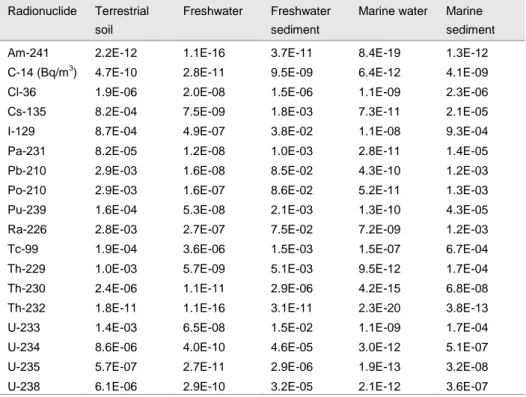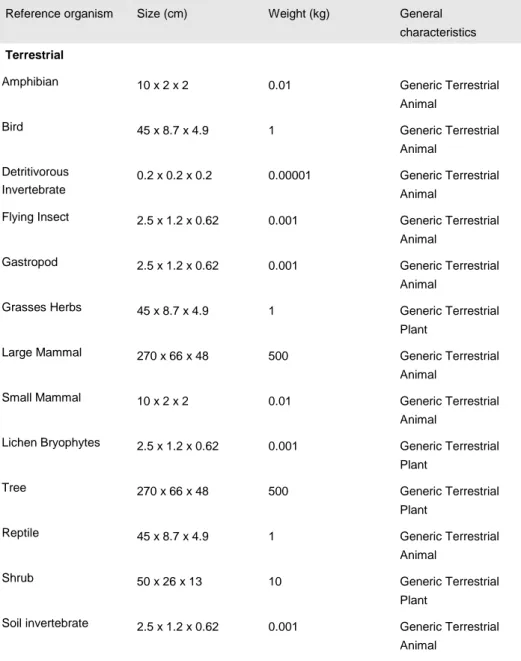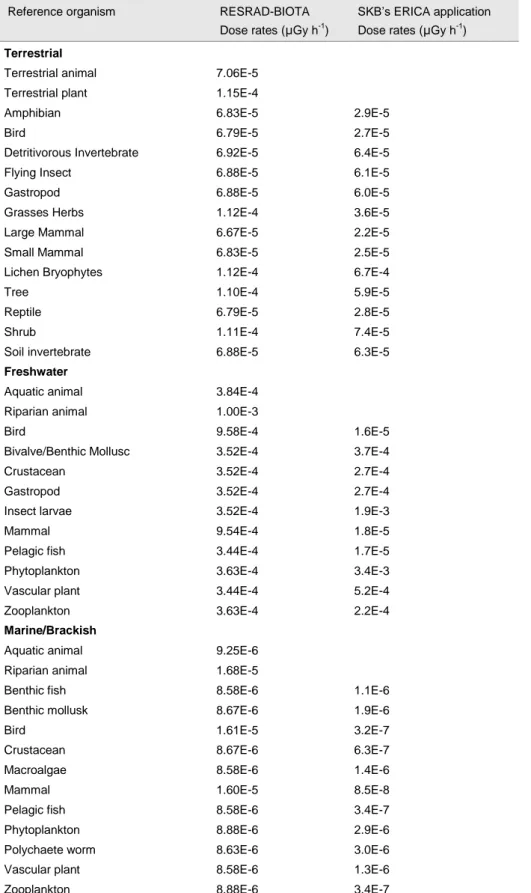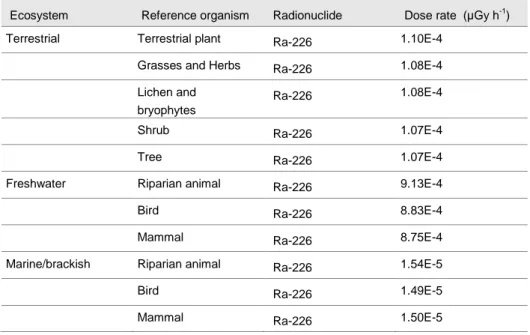Technical Note
Report number: 2015:45 ISSN: 2000-0456 Available at www.stralsakerhetsmyndigheten.se
Parallel assessment of effects
on non-human biota using
RESRAD-BIOTA
2015:45
SSM 2015:45
SSM:s perspektiv
BakgrundStrålsäkerhetsmyndigheten (SSM) granskar Svensk
Kärnbränslehanter-ing AB:s (SKB) ansöknKärnbränslehanter-ingar enligt lagen (1984:3) om kärnteknisk
verk-samhet om uppförande, innehav och drift av ett slutförvar för använt
kärnbränsle och av en inkapslingsanläggning. Som en del i granskningen
ger SSM konsulter uppdrag för att inhämta information i avgränsade
frågor. I SSM:s Technical note-serie rapporteras resultaten från dessa
konsultuppdrag.
Projektets syfte
Syftet med detta projekt är att undersöka robustheten i den utvärdering
avseende exponering av växter och djur som SKB genomfört med hjälp
av verktyget Erica Tool. Skulle slutsatserna kunnat bli signifikant
annor-lunda om ett annat utvärderingsverktyg använts istället?
Författarens sammanfattning
Robustheten i SKB:s utvärdering av exponering av växter och djur, vilken
genomförts med hjälp av verktyget Erica Tool, undersöktes genom att
genomföra en parallell utvärdering med hjälp av verktyget
RESRAD-BIOTA. Resultaten indikerar att inga dosrater förväntas överstiga
screeningvärdet 10 µGy h
-1. Det är därför osannolikt att en utvärdering
genomförd med RESRAD-BIOTA istället för Erica Tool skulle leda till
annorlunda slutsatser. De två verktygen beräknar dock i vissa fall
dos-rater som skiljer sig två storleksordningar från varandra. Det är därför
möjligt att de två dosmodellerna skulle leda till olika fokus avseende
vilka organismer som är mest utsatta om det vore så att ytterligare
undersökningar skulle genomföras för att komplettera den nuvarande
utvärderingen angående risker för växter och djur.
Projektinformation
Kontaktperson på SSM: Pål Andersson
Diarienummer avtal: SSM2010-1982-1
Diarienummer avrop: SSM2010-1982-14
Aktivitetsnummer: 7030004-01
SSM 2015:45
SSM perspective
BackgroundThe Swedish Radiation Safety Authority (SSM) reviews the Swedish
Nuclear Fuel Company’s (SKB) applications under the Act on Nuclear
Activities (SFS 1984:3) for the construction and operation of a
reposi-tory for spent nuclear fuel and for an encapsulation facility. As part of
the review, SSM commissions consultants to carry out work in order to
obtain information on specific issues. The results from the consultants’
tasks are reported in SSM’s Technical Note series.
Objective
The aim of this project is to evaluate the robustness of the assessment
of effects on non-human biota performed by SKB using the ERICA Tool.
Could the conclusion become significantly different if another
assess-ment tool were applied given the same input?
Summary by the author
The robustness of the assessment of effects on non-human biota using
the ERICA Tool, as performed by SKB, was tested by performing a
paral-lel assessment of effects on non-human biota using the dose model
RESRAD-BIOTA. Results suggest the calculated dose rates will not
exceed the screening level values of 10 µGy h
-1. Thus, it is unlikely that
a dose assessment performed with RESRAD-BIOTA instead of the ERICA
Tool would lead to different conclusions. However, the two dose models
calculate sometime dose rates with a two order of magnitude difference.
So it is possible that the two dose models would lead to different focus
regarding which organism that are most at risk if it were decided that
additional sampling were to be conducted to complement the current
safety assessment for non-human biota.
Project information
2015:45
Author:Date: November 2015
Report number: 2015:45 ISSN: 2000-0456 Available at www.stralsakerhetsmyndigheten.se
Karolina Stark
Stockholm University, Department of Ecology, Environment and Plant Sciences Stockholm
Parallel assessment of effects
on non-human biota using
RESRAD-BIOTA
Technical Note
SSM 2015:45
This report was commissioned by the Swedish Radiation Safety Authority
(SSM). The conclusions and viewpoints presented in the report are those
of the author(s) and do not necessarily coincide with those of SSM.
Contents
1. Introduction ... 3
2. Methods ... 5
2.1. Included radionuclides and activity concentrations ... 5
2.2. Included reference organisms ... 6
3. Results of the RESRAD-BIOTA application ... 9
4. Discussion ... 13
5. Conclusions... 15
6. References ... 17
APPENDIX 1 ... 19
2
3
1. Introduction
The Swedish Nuclear Fuel and Waste Management Company (SKB) has applied for permission to build a repository for spent nuclear fuel in Forsmark. According to regulation SSM FS 2008:37, sections 6 and 7, biological diversity and sustainable use of biological resources must be protected from harmful effects of ionizing radiation in the management process of a spent fuel repository. Therefore, SKB performed a risk assessment for non-human biota from potential releases from the planned repository. The Swedish Radiation Safety Authority (SSM) is responsible for reviewing SKB’s application. At present, an initial phase of SSM’s review of the safety assessment SR-Site by SKB is completed. SSM has concluded that SKB’s reporting is sufficiently comprehensive and of sufficient quality to justify a continuation of SSM’s review to a main review phase. While the overall goal of the initial review phase was to identify review issues and achieve a broad coverage of SKB’s safety assessment, assignments carried out during the main review phase are targeted on tasks and issues prioritized by SSM with the intention to indirectly or directly support SSM’s compliance judgments. This report presents results from an assignment that was part of SSM’s Main Review Phase for the SKB SR-Site safety assessment.
In SKB’s SR-Site the ERICA Tool (Brown et al., 2008) was used to assess effects on non-human biota from a potential leakage scenario from the proposed final disposal for spent nuclear fuel at the Forsmark site. The assessment was based on modeled activity concentrations for a leakage scenario called the central corrosion case in SR-Site. Maximum activity concentrations of radionuclides from a modeled future release were used as input to the ERICA Tool and dose rates to a number of site-specific organisms were calculated (Torudd, 2010). In addition, background dose rates to organisms was calculated to evaluate if total dose rates would results in values exceeding the applied screening dose rate of 10 µGy h-1. The conclusions in SKB’s assessment were that all calculated dose rates were below the screening level and that there is no reason to assume that any of the assessed species would be harmfully affected by the increased radiation exposure caused by a possible future release from the proposed repository for spent nuclear fuel at the Forsmark site. The radiation protection system for the environment and non-human biota is new. Performing a radiation risk assessment for the environment includes calculation of radiation doses to non-human biota. However, predicting doses to biota has proved to be challenging (e.g., Beresford, 2010; Johansen et al., 2012). Currently, existing dose models for non-human biota are still in need of verification and validation in field studies. Inter-comparison exercises within the International Atomic Energy Agency (IAEA) EMRAS and EMRAS II programs have showed that different users and applications may produce dose rate results to biota of several orders of magnitude difference (e.g., Beresford et al., 2010; Johansen et al., 2012).
The main aim of this assignment was to evaluate the robustness of a generic assessment of effects on non-human biota performed with the ERICA Tool. Could the conclusion become significantly different if another assessment tool were applied given the same input?
4
5
2. Methods
To test the robustness of a generic assessment of effects on non-human biota performed by SKB with the ERICA Tool a parallel assessment was performed using the RESRAD-BIOTA model version 1.5 (USDoE, 2004). The RESRAD-BIOTA model is used as a standard dose model in the USA for assessment of radiological risk for non-human biota.
2.1. Included radionuclides and activity concentrations
Maximum values over time and across all biosphere objects of modeled activity concentrations from a potential release presented in Table 3-2 in SKB report TR-10-08 (Torudd, 2010) were used as input to RESRAD-BIOTA. Only radionuclides that could be found in the default list of radionuclides in RESRAD-BIOTA were included in the assessment which resulted in a total of 18 out of 30 radionuclides (Table 1). It can be noted that Pa-231 is included in the RESRAD-BIOTA list of default radionuclides but was not included in the SKB ERICA application.
Table 1: Activity concentrations in soil (Bq/kg dw), freshwater and marine sediments (Bq/kg dw)
and water (Bq/l) used as input to RESRAD-BIOTA. Modified from Torudd (2010). Radionuclide Terrestrial
soil
Freshwater Freshwater sediment
Marine water Marine sediment Am-241 2.2E-12 1.1E-16 3.7E-11 8.4E-19 1.3E-12 C-14 (Bq/m3) 4.7E-10 2.8E-11 9.5E-09 6.4E-12 4.1E-09 Cl-36 1.9E-06 2.0E-08 1.5E-06 1.1E-09 2.3E-06 Cs-135 8.2E-04 7.5E-09 1.8E-03 7.3E-11 2.1E-05 I-129 8.7E-04 4.9E-07 3.8E-02 1.1E-08 9.3E-04 Pa-231 8.2E-05 1.2E-08 1.0E-03 2.8E-11 1.4E-05 Pb-210 2.9E-03 1.6E-08 8.5E-02 4.3E-10 1.2E-03 Po-210 2.9E-03 1.6E-07 8.6E-02 5.2E-11 1.3E-03 Pu-239 1.6E-04 5.3E-08 2.1E-03 1.3E-10 4.3E-05 Ra-226 2.8E-03 2.7E-07 7.5E-02 7.2E-09 1.2E-03 Tc-99 1.9E-04 3.6E-06 1.5E-03 1.5E-07 6.7E-04 Th-229 1.0E-03 5.7E-09 5.1E-03 9.5E-12 1.7E-04 Th-230 2.4E-06 1.1E-11 2.9E-06 4.2E-15 6.8E-08 Th-232 1.8E-11 1.1E-16 3.1E-11 2.3E-20 3.8E-13 U-233 1.4E-03 6.5E-08 1.5E-02 1.1E-09 1.7E-04 U-234 8.6E-06 4.0E-10 4.6E-05 3.0E-12 5.1E-07 U-235 5.7E-07 2.7E-11 2.9E-06 1.9E-13 3.2E-08 U-238 6.1E-06 2.9E-10 3.2E-05 2.1E-12 3.6E-07
6
2.2. Included reference organisms
Dose rates were calculated to RESRAD-BIOTA default organisms and reference organisms listed for each of the three ecosystems in Table 2 in Torudd and Saetre (2013). Because RESRAD-BIOTA only include two default organisms per ecosystem this meant that new reference organisms corresponding to reference organisms in ERICA had to be added in RESRAD-BIOTA tier 3. The new organisms were given dimensions and characteristics from one out of eight RESRAD default geometries. All included reference organisms and their dimensions are listed in Table 2.
Table 2:Reference organisms included in the dose rate calculations in RESRAD-BIOTA with their dimensions and general characteristics.
Reference organism Size (cm) Weight (kg) General characteristics
Terrestrial
Amphibian 10 x 2 x 2 0.01 Generic Terrestrial Animal
Bird 45 x 8.7 x 4.9 1 Generic Terrestrial Animal
Detritivorous
Invertebrate
0.2 x 0.2 x 0.2 0.00001 Generic Terrestrial Animal
Flying Insect 2.5 x 1.2 x 0.62 0.001 Generic Terrestrial Animal
Gastropod 2.5 x 1.2 x 0.62 0.001 Generic Terrestrial Animal
Grasses Herbs 45 x 8.7 x 4.9 1 Generic Terrestrial Plant
Large Mammal 270 x 66 x 48 500 Generic Terrestrial Animal Small Mammal 10 x 2 x 2 0.01 Generic Terrestrial
Animal
Lichen Bryophytes 2.5 x 1.2 x 0.62 0.001 Generic Terrestrial Plant
Tree 270 x 66 x 48 500 Generic Terrestrial Plant
Reptile 45 x 8.7 x 4.9 1 Generic Terrestrial Animal
Shrub 50 x 26 x 13 10 Generic Terrestrial Plant
Soil invertebrate 2.5 x 1.2 x 0.62 0.001 Generic Terrestrial Animal
7
Aquatic
Bird 45 x 8.7 x 4.9 1 Generic Riparian Animal
Bivalve/Benthic Mollusc
2.5 x 1.2 x 0.62 0.001 Generic Aquatic Animal Crustacean 2.5 x 1.2 x 0.62 0.001 Generic Aquatic
Animal Gastropod 2.5 x 1.2 x 0.62 0.001 Generic Aquatic
Animal Insect larvae 2.5 x 1.2 x 0.62 0.001 Generic Aquatic
Animal Mammal 50 x 26 x 13 10 Generic Aquatic
Animal Pelagic/Benthic fish 45 x 8.7 x 4.9 1 Generic Aquatic
Animal Phytoplankton 0.2 x 0.2 x 0.2 0.00001 Generic Aquatic
Plant
Vascular plant 45 x 8.7 x 4.9 1 Generic Aquatic Plant
Zooplankton 0.2 x 0.2 x 0.2 0.00001 Generic Aquatic Animal Macroalgae 45 x 8.7 x 4.9 1 Generic Aquatic
Plant
Polychaete worm 10 x 2 x 2 0.01 Generic Aquatic Animal
8
9
3. Results of the RESRAD-BIOTA
application
The resulting dose rates to reference organisms from input activity concentrations of 18 radionuclides to RESRAD-BIOTA tier 3 are presented in Table 3 next to deterministic estimates of dose rates from SKB’s assessment using the ERICA Tool tier 3 in Torudd and Saetre (2013).
Over all, none of the dose rates to reference organisms calculated with RESRAD-BIOTA (Table 3) exceeded the screening dose rate values of 10 µGy h-1. Given the low input activity concentrations modeled for a potential leakage scenario this is the same result as in the SKB ERICA application. Thus, because the resulting dose rates to biota are below 10 µGy h-1 it is unlikely that they will cause a harmful effect on populations of non-human biota.
However, some results from this assessment are interesting to notice. In the results for terrestrial ecosystems all dose rates from the RESRAD-BIOTA application were higher than in the SKB ERICA application. The highest dose rates were calculated with RESRAD to terrestrial plant, grasses and herbs, lichen and bryophytes, shrub, and tree. In the SKB ERICA application only lichen and bryophytes showed similar results, all other dose rates to plants were one order of magnitude lower.
In the results for freshwater ecosystems the highest dose rate was calculated with RESRAD-BIOTA to riparian animal while in the SKB ERICA application phytoplankton and insect larvae were predicted to receive the highest dose rates. Dose rates to bird, mammal and pelagic fish were predicted to be one order of magnitude lower in the SKB ERICA application than in the RESRAD-BIOTA application.
For marine/brackish ecosystems all dose rates calculated with RESRAD-BIOTA were higher than in the SKB ERICA application. The highest dose rates were calculated to riparian animal, bird, and mammal with the RESRAD-BIOTA application. In the SKB ERICA application phytoplankton and polychaete worm were predicted to get the highest dose rates. Dose rates to bird, crustacean, mammal, pelagic fish, and zooplankton were predicted to be one to two orders of magnitude lower than predicted with the RESRAD-BIOTA application.
10
Table 3: Dose rates (µGy h-1) to reference organisms included in RESRAD-BIOTA tier 3 for terrestrial and aquatic ecosystems. To the right are dose rates from deterministic estimates from SKB’s assessment using the ERICA Tool tier 3 presented in Torudd and Saetre (2013). Reference organism RESRAD-BIOTA
Dose rates (µGy h-1)
SKB’s ERICA application Dose rates (µGy h-1)
Terrestrial
Terrestrial animal 7.06E-5 Terrestrial plant 1.15E-4
Amphibian 6.83E-5 2.9E-5
Bird 6.79E-5 2.7E-5
Detritivorous Invertebrate 6.92E-5 6.4E-5
Flying Insect 6.88E-5 6.1E-5
Gastropod 6.88E-5 6.0E-5
Grasses Herbs 1.12E-4 3.6E-5
Large Mammal 6.67E-5 2.2E-5
Small Mammal 6.83E-5 2.5E-5
Lichen Bryophytes 1.12E-4 6.7E-4
Tree 1.10E-4 5.9E-5
Reptile 6.79E-5 2.8E-5
Shrub 1.11E-4 7.4E-5
Soil invertebrate 6.88E-5 6.3E-5
Freshwater
Aquatic animal 3.84E-4 Riparian animal 1.00E-3
Bird 9.58E-4 1.6E-5
Bivalve/Benthic Mollusc 3.52E-4 3.7E-4
Crustacean 3.52E-4 2.7E-4
Gastropod 3.52E-4 2.7E-4
Insect larvae 3.52E-4 1.9E-3
Mammal 9.54E-4 1.8E-5
Pelagic fish 3.44E-4 1.7E-5
Phytoplankton 3.63E-4 3.4E-3
Vascular plant 3.44E-4 5.2E-4
Zooplankton 3.63E-4 2.2E-4
Marine/Brackish
Aquatic animal 9.25E-6 Riparian animal 1.68E-5
Benthic fish 8.58E-6 1.1E-6
Benthic mollusk 8.67E-6 1.9E-6
Bird 1.61E-5 3.2E-7
Crustacean 8.67E-6 6.3E-7
Macroalgae 8.58E-6 1.4E-6
Mammal 1.60E-5 8.5E-8
Pelagic fish 8.58E-6 3.4E-7
Phytoplankton 8.88E-6 2.9E-6
Polychaete worm 8.63E-6 3.0E-6 Vascular plant 8.58E-6 1.3E-6
Zooplankton 8.88E-6 3.4E-7
11
Of the 18 radionuclides in this RESRAD-BIOTA application the one radionuclide that contributed most to the total dose in all three ecosystems was Ra-226. In terrestrial ecosystems the highest dose rate from Ra-226 was to plants (Table 4). In freshwater ecosystems the highest dose rate from Ra-226 was to riparian animal, bird, and mammal. Finally, in marine/brackish ecosystems the highest dose rate from Ra-226 was to riparian animal, bird, and mammal.
Table 4:The highest dose rates from the radionuclide that contributed the most to the total dose in all three ecosystems.
Ecosystem Reference organism Radionuclide Dose rate (µGy h-1) Terrestrial Terrestrial plant Ra-226 1.10E-4
Grasses and Herbs Ra-226 1.08E-4 Lichen and
bryophytes
Ra-226 1.08E-4 Shrub Ra-226 1.07E-4 Tree Ra-226 1.07E-4 Freshwater Riparian animal Ra-226 9.13E-4 Bird Ra-226 8.83E-4 Mammal Ra-226 8.75E-4 Marine/brackish Riparian animal Ra-226 1.54E-5 Bird Ra-226 1.49E-5 Mammal Ra-226 1.50E-5
12
13
4. Discussion
The low activity concentrations from the modeled leakage scenario called the central corrosion case in SKB’s SR-Site results in low dose rates to reference organisms in this RESRAD-BIOTA application that do not exceed the screening dose rate value for non-human biota of 10 µGy h-1. This makes the modeled input values and the underlying radionuclide model the critical point in SKB’s environmental risk assessment.
The RESRAD-BIOTA application resulted in one order of magnitude higher dose rates to plants than in the SKB ERICA application. This could be due to differences in plant geometry in the two models and that in RESRAD-BIOTA plants are assumed to be 50% in soil while in the ERICA Tool plants are assumed to be on the soil surface. Moreover, the assumed default weights of the RESRAD-BIOTA default geometries may also be a cause to these results because they are perhaps a bit too high for plants.
In this RESRAD-BIOTA application the riparian animal were predicted to receive the highest dose rate in aquatic ecosystems. In RESRAD-BIOTA a riparian animal is assumed to be situated at the sediment-water interface and sediment will contribute to both internal and external dose rates. For an aquatic animal sediment will only contribute to external dose rates. This may result in differences in the total dose to these different kinds of reference animals.
The radionuclide that contributed the most to the total dose rate in this RESRAD-BIOTA application was Ra-226. In the SKB ERICA application the radionuclides Po-210, Ra-226, and Np-237 were found to contribute the most to dose rate to reference organisms (Table 5-3, Torudd, 2010). Np-237 was not included in the currently RESRAD-BIOTA application.
The choice of reference organism by different assessors to represent site-specific species may influence dose assessment results. This has been demonstrated by several inter-comparison exercises within the IAEA EMRAS II program (e.g., Johansen et al., 2012). In SKB’s ERICA application the choice of reference organism to represent site-specific species could have been made differently, for example, in Table 1 from Torudd and Saetre (2013) ‘alder’ can be represented by a ‘shrub’ or a ‘tree’ and ‘reed’ can be represented by ‘forbes and sedges’ or ‘grasses and herbs’. Which of the reference organism that is chosen will affect the concentration ratio and dosimetry geometry in the final dose assessment.
14
15
5. Conclusions
Overall, none of the calculated dose rates to reference organisms in this RESRAD-BIOTA application exceeded the screening dose rate values of 10 µGy h-1. Therefore, it is unlikely that an assessment using RESRAD-BIOTA instead of the ERICA Tool would result in significantly different conclusions in a safety assessment for spent nuclear fuel. However, the two dose models for non-human biota result in dose rates with a sometimes two order of magnitude difference for some reference organisms. This could result in different approaches and different focus organisms if it was decided that, for example, the safety assessment needed additional sampling efforts.
16
17
6. References
Beresford NA. The transfer of radionuclides to wildlife. Radiat Environ Biophys 2010; 50: 504-508.
Beresford N.A., Barnett C.L., Brown J.E., Cheng J.J., Copplestone D., Gashchak S., et al. Predicting the radiation exposure of terrestrial wildlife in the Chernobyl exclusion zone: an international comparison of approaches. J Radiol Prot 2010; 30: 341-73.
Brown J.E., Alfonso B., Avila R., Beresford N.A., Copplestone D., Pröhl G., Ulanovsky A. The ERICA Tool. J Environ Radioact 2008; 99: 1371-1383.
Johansen M.P., Barnett C.L., Beresford N.A., Brown J.E., Cerne M., Howard B.J. et al. Assessing doses to terrestrial wildlife at a radioactive waste disposal site: Inter-comparison of modeling approaches. Sci Tot Environ 2012; 427-428: 238-246. Torudd J. 2010. SKB report TR-10-08. Long term radiological effects on plants and animals of a deep geological repository. SKB, Sweden
Torudd J., and Saetre P. 2013. Assessment of long-term radiological effects on plants and animals from a deep geological repository: No discernible impact detected. AMBIO 42: 506-516.
United States Department of Energy (USDoE). RESRAD-BIOTA: A tool for implementing a graded approach to biota dose evaluation. User’s guide, version 1. DOE Report No. DOE/EH-0676; ISCORS Technical Report 2004-02, United States Department of Energy; 2004.
18
19
APPENDIX 1
Coverage of SKB reports
Table 1:SKB reports reviewed in this review assignment of SR-Site for radiological effects on
non-human biota.
Reviewed report Reviewed sections Comments TR-10-08 Long term
radiological effects on plants and animals of a deep geological repository
All sections The main report reviewed in this assignment
Strålsäkerhetsmyndigheten Swedish Radiation Safety Authority
SE-171 16 Stockholm Tel: +46 8 799 40 00 E-mail: registrator@ssm.se Solna strandväg 96 Fax: +46 8 799 40 10 Web: stralsakerhetsmyndigheten.se 2015:45 The Swedish Radiation Safety Authority has a
comprehensive responsibility to ensure that society is safe from the effects of radiation. The Authority works to achieve radiation safety in a number of areas: nuclear power, medical care as well as commercial products and services. The Authority also works to achieve protection from natural radiation and to increase the level of radiation safety internationally. The Swedish Radiation Safety Authority works proactively and preventively to protect people and the environment from the harmful effects of radiation, now and in the future. The Authority issues regulations and supervises compliance, while also supporting research, providing training and information, and issuing advice. Often, activities involving radiation require licences issued by the Authority. The Swedish Radiation Safety Authority maintains emergency preparedness around the clock with the aim of limiting the aftermath of radiation accidents and the unintentional spreading of radioactive substances. The Authority participates in international co-operation in order to promote radiation safety and finances projects aiming to raise the level of radiation safety in certain Eastern European countries.
The Authority reports to the Ministry of the Environment and has around 300 employees with competencies in the fields of engineering, natural and behavioural sciences, law, economics and communications. We have received quality, environmental and working environment certification.




